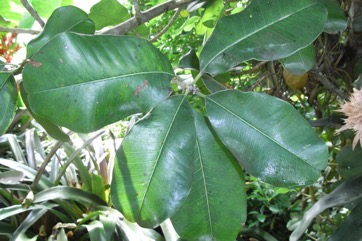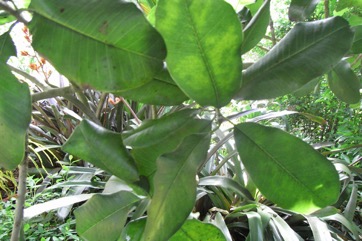Ceylon ironwood tree

A tropical plant. Plants grow in thickets at low altitudes. In India they grow in dry forests in the West. Deccan. It grows along roadsides and wastelands. It can be along seashores. It grows in semi-arid conditions.
Also known as:
Bakula, Gang neo, Kaeks, Kes, Ket, Khayay, Khiluni, Khirakuli, Khirani, Khiri, Khirikoli, Khirkhejur, Khirni, Manjipala, Paalabeera Chettu, Paal palam, Pala, Palai, Palla, Palu, Pohon sawo manila, Raini, Rajan, Ranjana, Rayan, Ryan, Sivandi, Sukkilam, Tie xian zi
Synonyms
- Mimusops hexandra Roxb.
- Mimusops indica A. DC.
Edible Portion
- Fruit, Seeds - oil
Where does Ceylon ironwood tree grow?
Found in: Asia, Bangladesh, Cambodia, China, Himalayas, India, Indochina, Indonesia, Myanmar, Nepal, Pakistan, SE Asia, Sri Lanka, Thailand, Vietnam
Notes: The seeds have medicinal value. There are about 75 Manilkara species.
Status: Ripe fruit are sold in markets. They are collected in large quantities. It is a cultivated fruit tree.
Growing Ceylon ironwood tree
Cultivation: Plants can be grown from seed. They can also be grown from cuttings or by air-layering. They can be grafted.
Edible Uses: The seeds contain edible oil. The ripe fruit are eaten fresh or dried. They are very sweet. They are also put into a pot with sugar to form a sticky black mass that is eaten. The bark is added to palm sugar to restrict fermentation.
Production: It is slow growing. In India the fruit are available October to April. The seeds contain 25% edible oil.
Nutrition Info
per 100g edible portion| Edible Part | Energy (kcal) | Protein (g) | Iron (mg) | Vitamin A (ug) | Vitamin c (mg) | Zinc (mg) | % Water |
|---|---|---|---|---|---|---|---|
| - | - | - | - | - | - |
Ceylon ironwood tree Photos


References
Ambasta, S.P. (Ed.), 2000, The Useful Plants of India. CSIR India. p 355
Arora, R. K., 2014, Diversity in Underutilized Plant Species - An Asia-Pacific Perspective. Bioversity International. p 77
Ashton, M. S., et al 1997, A Field Guide to the Common Trees and Shrubs of Sri Lanka. WHT Publications Ltd. pdf p 363
Bajpai, O., et al, 2015, Tree species of the Himalayan Terai region of Uttar Pradesh, India: a checklist. Check List 11(4): 1718
BARC, 2016, State of Biodiversity for Food and Agriculture in Bangladesh. Bangladesh Agricultural Research Council.
Basha, S. K. M., Ethnobotanical Trees of Sri Lanka Malleswara Wildlife Sanctuary; Eastern Ghats, Andhra Pradesh.
Bole, P.V., & Yaghani, Y., 1985, Field Guide to the Common Trees of India. OUP p 71
Chaudhary, L. B., et al, 2014, Tree Resources of Katerniaghat Wildlife Sanctuary, Uttar Pradesh, India with especial emphasis on Conservation Status, Phenology and Economic Values. International Journal of Environment. 3(1)
Dobriyal, M. J. R. & Dobriyal, R., 2014, Non Wood Forest Produce an Option for Ethnic Food and Nutritional Security in India. Int. J. of Usuf. Mngt. 15(1):17-37
Dubard, Ann. Inst. Bot.- Géol. Colon. Marseille, sér. 3, 3: 9. 1915.
Facciola, S., 1998, Cornucopia 2: a Source Book of Edible Plants. Kampong Publications, p 227
Flora of China. Vol. 16 p 206
Flora of Pakistan. www.eFloras.org
Garner, R.J., and Chaudhri, S.A., (Ed.) 1976, The Propagation of Tropical fruit Trees. FAO/CAB. p 487
Hedrick, U.P., 1919, (Ed.), Sturtevant's edible plants of the world. p 415 (As Mimusops hexandra)
Hu, Shiu-ying, 2005, Food Plants of China. The Chinese University Press. p 620
INFOODSUpdatedFGU-list.xls
Khan, D. & Shaukat, S.S., 2006, The Fruits of Pakistan: Diversity, Distribution, Trends of Production and Use. Int. J. Biol. Biotech., 3(3):463-499
Krishen P., 2006, Trees of Delhi, A Field Guide. DK Books. p 138
Misra S. & Misra M., 2016, Ethnobotanical and Nutritional Evaluation of Some Edible Fruit Plants of Southern Odisha, India. International Journal of Advances in Agricultural Science and Technology, Vol.3 Issue.1, March- 2016, pg. 1-30
Pasha, M. K. & Uddin, S. B., 2019, Minor Edible Fruits of Bangladesh. Bangladesh J. Plant Taxon. 26(2): 299–313
Patel, P. R. & Ramana Rao, T. V., 2009, Physiological changes in relation to growth and ripening of khirni [Manilkara hexandra (Roxb.) Dubard] fruit, Fruits, Vol. 64, p. 139-146
Pham-Hoang Ho, 1999, An Illustrated Flora of Vietnam. Nha Xuat Ban Tre. p 631
Phon, P., 2000, Plants used in Cambodia. © Pauline Dy Phon, Phnom Penh, Cambodia. p 428
Rajapaksha, U., 1998, Traditional Food Plants in Sri Lanka. HARTI, Sri Lanka. p 460
Reddy, B. M., 2012, Wild edible plants of Chandrapur district, Maharashtra, India. Indian Journal of Natural Products and Resources. 3(1) pp 110-117
Reddy, K.R., 1989, Additional Notes on the Wild Edible Plants of India. J. Econ. Tax. Bot. Vol. 13 No. 1 pp 125-127 (As Mimusops hexandra)
Reddy, K. N. et al, 2007, Traditional knowledge on wild food plants in Andhra Pradesh. Indian Journal of Traditional Knowledge. Vol. 6(1): 223-229
Reis, S. V. and Lipp, F. L., 1982, New Plant Sources for Drugs and Foods from the New York Botanical Garden herbarium. Harvard. p 234
Sahni, K.C., 2000, The Book of Indian Trees. Bombay Natural History Society. Oxford. p 122
Setiya, A. V., et al, 2016, Exploration and documentation of some wild edible plants used by the aboriginals from Gadchiroli District (M.S.) India. International Advanced Research Journal in Science, Engineering and Technology. 3(7)
Shah, G.L., 1984, Some economically important plant of Salsette Island near Bombay. J. Econ. Tax. Bot. Vol. 5 No. 4 pp 753-765
Singh, H.B., Arora R.K.,1978, Wild edible Plants of India. Indian Council of Agricultural Research, New Delhi. p 66
Singh, V. and Singh, P., 1981, Edible Wild Plants of Eastern Rajasthan. J. Econ. Tax. Bot. Vol 2 pp 197-207 (As Mimusops hexandra)
Soerianegara, I. & Lemmens, R. H. M. L., (Eds.) 1993, Timber trees: Major commercial timbers. Plant Resources of South-East Asia. Wageningen. No. 5(1). p 294
Sukarya, D. G., (Ed.) 2013, 3,500 Plant Species of the Botanic Gardens of Indonesia. LIPI p 384
Swaminathan, M.S., and Kochnar, S.L., 2007, An Atlas of Major Flowering Trees in India. Macmillan. p 179
Tamil herbs, 2007, Edible Plants of the Tropical Dry Evergreen Forest.
Tomar, A., Kumar, A., & Dubey, K., 2002, Underutilized Wild Edible fruits of Nutritional and Medicinal Value. J. Res. Educ. Indian Med., Vol XX1
Upreti, K., et al, 2010, Diversity and Distribution of Wild Edible Fruit Plants of Uttarakhand. Bioversity Potentials of the Himalaya. p 174
USDA, ARS, National Genetic Resources Program. Germplasm Resources Information Network - (GRIN). [Online Database] National Germplasm Resources Laboratory, Beltsville, Maryland. Available: www.ars-grin.gov/cgi-bin/npgs/html/econ.pl (10 April 2000)
WATT, (As Mimusops hexandra)
World Checklist of Useful Plant Species 2020. Royal Botanic Gardens, Kew